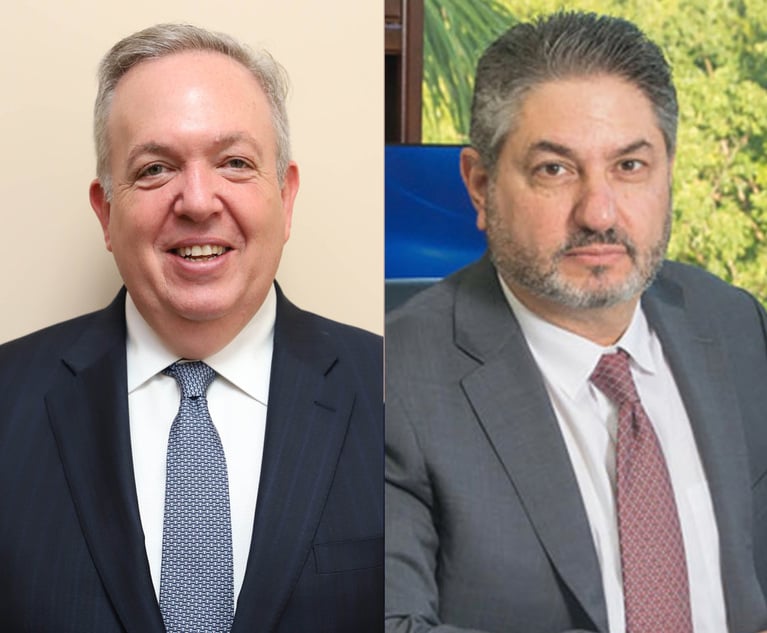The Department of Labor Issues Final Rule Regarding Overtime Updates
On Sept. 24, the U.S. Department of Labor (DOL) announced a final rule, which updates the earnings thresholds necessary to exempt executive, administrative and professional employees from the Fair Labor Standards Act's minimum wage and overtime pay requirements and allows employers to count a portion of certain bonuses or commissions toward meeting the salary level.
September 24, 2019 at 05:53 PM
5 minute read
 Taylor Greene of Allen Norton & Blue.
Taylor Greene of Allen Norton & Blue.On Sept. 24, the U.S. Department of Labor (DOL) announced a final rule, which updates the earnings thresholds necessary to exempt executive, administrative and professional employees from the Fair Labor Standards Act's minimum wage and overtime pay requirements and allows employers to count a portion of certain bonuses or commissions toward meeting the salary level. The final rule will be effective on Jan. 1, 2020.
The DOL is updating both the minimum weekly standard salary level and the total annual compensation requirement for "highly compensated employees" to more accurately reflect growth in wages and salaries. The new thresholds account for growth in employee earnings, since the currently enforced thresholds were set in 2004. The DOL believes that the update to the standard salary level will maintain the traditional purposes of the salary level test and will help employers more readily identify exempt employees. The DOL is also revising the special salary levels for employees in U.S. territories and the special base rate for employees in the motion picture producing industry.
In the final rule, the DOL is:
- Raising the "standard salary level" from the currently enforced level of $455 per week ($23,000 per year) to $684 per week (equivalent to $35,568 per year for a full-year worker);
- Raising the total annual compensation requirement for "highly compensated employees" from the currently enforced level of $100,000 per year to $107,432 per year;
- Allowing employers to use nondiscretionary bonuses and incentive payments (including commissions) paid at least annually to satisfy up to 10% of the standard salary level, in recognition of evolving pay practices; and
- Revising the special salary level for workers in U.S. territories and the motion picture industry.
In 2014, the Obama administration tried to double the threshold to include workers earning up to $913 per week ($47,476 per year). This change created quite an uproar. In 2016, a final rule to change the overtime thresholds was enjoined by the U.S. District Court for the Eastern District of Texas on Nov. 22, 2016, and was subsequently invalidated by that court. As of Nov. 6, 2017, the U.S. Court of Appeals for the Fifth Circuit has held the appeal in abeyance pending further rulemaking regarding a revised salary threshold. As the 2016 final rule was invalidated, the DOL has consistently enforced the 2004 level throughout the last 15 years: $455 per week standard salary level and a $100,000 total annual compensation threshold for highly compensated employees.
The new thresholds account for growth in employee earnings since the thresholds were last updated in 2004. Nearly every person who commented on the department's 2017 request for information, participated at listening sessions in 2018 regarding the regulations, or commented on the notice of proposed rulemaking agreed that the thresholds needed to be updated for this reason. The DOL estimates that 1.3 million additional workers will be entitled to wage and overtime pay as a result of the increase to the standard salary level. The DOL also estimates that an additional 102,000 workers will be entitled to overtime pay as a result of the increase to the "highly compensated employees" compensation level. In the final rule, the DOL also permits employers to use nondiscretionary bonuses and incentive payments to satisfy up to 10% of the standard salary level. For employers to credit nondiscretionary bonuses and incentive payments toward a portion of the standard salary level test, they must make such payments on an annual or more frequent basis.
The DOL believes this change is necessary because, based on their experience, fixed earning thresholds become substantially less effective over time. Furthermore, lengthy delays between threshold updates necessitate disruptively large increases when overdue updates ultimately occur. Accordingly, in the final rule, the DOL reaffirms its intent to update the earnings thresholds more regularly in the future through notice-and-comment rulemaking.
It should also be noted that the FLSA provides minimum wage-and-hour standards but does not prevent Florida from establishing its own protective standards. If Florida were to establish a more protective standard than the new provisions of the FLSA, then the higher standard would apply.
Additional information about the final rule is available on the DOL website.
This final rule has been submitted to the Office of the Federal Register (OFR) for publication and is currently pending placement on public inspection at the OFR and publication in the Federal Register. This version of the final rule may vary slightly from the published document if minor technical or formatting changes are made during the OFR review process. Only the version published in the Federal Register is the official final rule.
Taylor Greene is an associate with the Miami-based law firm Allen Norton & Blue, the statewide firm devoted exclusively to the practice of labor and employment Law. Contact him at [email protected].
This content has been archived. It is available through our partners, LexisNexis® and Bloomberg Law.
To view this content, please continue to their sites.
Not a Lexis Subscriber?
Subscribe Now
Not a Bloomberg Law Subscriber?
Subscribe Now
NOT FOR REPRINT
© 2025 ALM Global, LLC, All Rights Reserved. Request academic re-use from www.copyright.com. All other uses, submit a request to [email protected]. For more information visit Asset & Logo Licensing.
You Might Like
View All
Conversation Catalyst: Transforming Professional Advancement Through Strategic Dialogue
5 minute read
SEC Whistleblower Program: What to Expect Under the Trump Administration
6 minute read
Turning the Shock of a January Marital Split Into Effective Strategies for Your Well-Being
5 minute read
Trending Stories
- 1Connecticut Movers: New Laterals, Expanding Teams
- 2Eliminating Judicial Exceptions: The Promise of the Patent Eligibility Restoration Act
- 3AI in Legal: Disruptive Potential and Practical Realities
- 4One Court’s Opinion on Successfully Bankruptcy Proofing a Borrower
- 5Making the Case for Workflow Automation
Who Got The Work
J. Brugh Lower of Gibbons has entered an appearance for industrial equipment supplier Devco Corporation in a pending trademark infringement lawsuit. The suit, accusing the defendant of selling knock-off Graco products, was filed Dec. 18 in New Jersey District Court by Rivkin Radler on behalf of Graco Inc. and Graco Minnesota. The case, assigned to U.S. District Judge Zahid N. Quraishi, is 3:24-cv-11294, Graco Inc. et al v. Devco Corporation.
Who Got The Work
Rebecca Maller-Stein and Kent A. Yalowitz of Arnold & Porter Kaye Scholer have entered their appearances for Hanaco Venture Capital and its executives, Lior Prosor and David Frankel, in a pending securities lawsuit. The action, filed on Dec. 24 in New York Southern District Court by Zell, Aron & Co. on behalf of Goldeneye Advisors, accuses the defendants of negligently and fraudulently managing the plaintiff's $1 million investment. The case, assigned to U.S. District Judge Vernon S. Broderick, is 1:24-cv-09918, Goldeneye Advisors, LLC v. Hanaco Venture Capital, Ltd. et al.
Who Got The Work
Attorneys from A&O Shearman has stepped in as defense counsel for Toronto-Dominion Bank and other defendants in a pending securities class action. The suit, filed Dec. 11 in New York Southern District Court by Bleichmar Fonti & Auld, accuses the defendants of concealing the bank's 'pervasive' deficiencies in regards to its compliance with the Bank Secrecy Act and the quality of its anti-money laundering controls. The case, assigned to U.S. District Judge Arun Subramanian, is 1:24-cv-09445, Gonzalez v. The Toronto-Dominion Bank et al.
Who Got The Work
Crown Castle International, a Pennsylvania company providing shared communications infrastructure, has turned to Luke D. Wolf of Gordon Rees Scully Mansukhani to fend off a pending breach-of-contract lawsuit. The court action, filed Nov. 25 in Michigan Eastern District Court by Hooper Hathaway PC on behalf of The Town Residences LLC, accuses Crown Castle of failing to transfer approximately $30,000 in utility payments from T-Mobile in breach of a roof-top lease and assignment agreement. The case, assigned to U.S. District Judge Susan K. Declercq, is 2:24-cv-13131, The Town Residences LLC v. T-Mobile US, Inc. et al.
Who Got The Work
Wilfred P. Coronato and Daniel M. Schwartz of McCarter & English have stepped in as defense counsel to Electrolux Home Products Inc. in a pending product liability lawsuit. The court action, filed Nov. 26 in New York Eastern District Court by Poulos Lopiccolo PC and Nagel Rice LLP on behalf of David Stern, alleges that the defendant's refrigerators’ drawers and shelving repeatedly break and fall apart within months after purchase. The case, assigned to U.S. District Judge Joan M. Azrack, is 2:24-cv-08204, Stern v. Electrolux Home Products, Inc.
Featured Firms
Law Offices of Gary Martin Hays & Associates, P.C.
(470) 294-1674
Law Offices of Mark E. Salomone
(857) 444-6468
Smith & Hassler
(713) 739-1250






